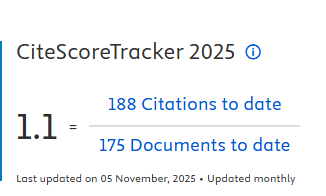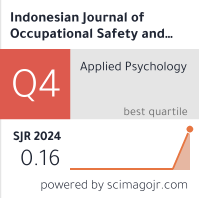Noise Risk Assessment Using Noise Mapping Analysis Method and Noise Control at a Steel Company in Cilegon
Downloads
Keywords: noise, noise mapping, steel company
Alfidyani, K. S., Lestantyo, D. and Wahyuni, I. (2020) ‘Hubungan Pelatihan K3, Penggunaan APD, Pemasangan Safety Sign dan Penerapan SOP dengan Terjadinya Risiko Kecelakaan Kerja (Studi Pada Industri Garmen Kota Semarang)', Jurnal Kesehatan Masyarakat e-Journal, 8(4), pp. 478–484.
Amalia, R., Jayanti, S. and Kurniawan, B. (2015) ‘Analisis Pengendalian Kebisingan di Area Body Minibus Perusahaan Karoseri Tahun 2015', Jurnal Kesehatan Masyarakat (e-Journal), 3(3), pp. 616–626.
Andani, K. W. (2016) ‘Kelelahan Subjektif Individu di PT X Jakarta', The Indonesian Journal of Occupational Safety and Health, 5(2), pp. 112–120.
Andriani, K. W. (2016) ‘Hubungan Umur, Kebisingan dan Temperatur Udara dengan Kelelahan Subjektif Individu di PT X Jakarta', The Indonesian Journal of Occupational Safety and Health, 5(2), pp. 112–120.
Ariestyajuni, A. (2019) ‘Dampak Pajanan Kebisingan Mesin Extruder Terhadap Gangguan Komunikasi pada Pekerja di PT X Sidoarjo', Medical Technology and Public Health Journal, 3(1), pp. 17–22.
Auliya, N. (2017) ‘Pengaruh Shift Kerja Terhadap Tingkat Kelelahan Kerja dan Dampaknya Terhadap Kinerja Operator Produksi ARV PT Kimia Farma (Persero) Tbk. Unit Plant Jakarta', Jurnal Nusantara Aplikasi Manajemen Bisnis, 2(2), pp. 66–74.
Bando, J. J., Kawatu, P. A. T. and Ratag, B. T. (2020) ‘Gambaran Penerapan Program Keselamatan dan Kesehatan Kerja Rumah Sakit (K3RS) di Rumah Sakit Advent Manado', Jurnal Kesehatan Masyarakat (e-Journal), 9(2), pp. 33–40.
Eryani, Y. M., Wibowo, C. A. and Saftarina, F. (2017) ‘Faktor Risiko Terjadinya Gangguan Pendengaran Akibat', Science Journal, 7(4), pp. 112–117.
Government Regulation Number 50 (2012) Application of the Workplace Safety and Health Management System, Application of the Workplace Safety and Health Management System. Jakarta: Indonesian Government.
Hamid, M. (2020) ‘The Analysis of Hearing Threshold Level of Noise Exposed Workers in Circulator Loom Unit', The Indonesian Journal of Occupational Safety and Health, 9(2), pp. 214–221.
Indonesian National Standardization Institute (2004) Nilai Ambang Batas Iklim Kerja (Panas), Kebisingan, Getaran Tangan-Lengan dan Radiasi Sinar Ultra Ungu di Tempat Kerja. Jakarta: Badan Standarisasi Nasional.
Khairuzzaman, M. Q. (2016) Gambaran Risiko Gangguan Pendengaran pada Pekerja Berdasarkan Pemetaan Intensitas Kebisingan di PT Bakrie Metal Industries Bekasi Tahun 2015,.Undergraduate Thesis. Faculty of Medicine and Health Sciences, Universitas Islam Negeri Syarif Hidayatullah Jakarta.
Law of The Republic Indonesia Number 1 (1970) Regarding Work Safety. Jakarta: Republic of Indonesia.
Law of The Republic Indonesia Number 13 (2003) Employment. Jakarta: Republic of Indonesia.
Maulana, I., Jayanti, S. and Suroto, S. (2016) ‘Analisis Implementasi Hearing Conservation Program di PT Kaltim Prima Coal', Jurnal Kesehatan Masyarakat (e-Journal), 4(4), pp. 682–689.
Minister of Manpower Regulation Number 5 (2018) Concerning Safety and Health. Jakarta: Ministry of Manpower Republic of Indonesia.
Minister of Manpower Regulation Number 8 (2010) Personal Protective Equipment. Jakarta: Ministry of Manpower Republic of Indonesia.
Ministry of Manpower Regulation Number 2 (1980) Worker Health Inspection in Implementing Work Safety. Jakarta: Ministry of Manpower Republic of Indonesia.
Nabinatul, F. (2015) ‘Analisis Pengaruh Kebisingan Terhadap Tingkat Konsentrasi Kerja Pada Tenaga Kerja di Bagian Proses PT Iskandar Indah Printing Textile Surakarta', Jurnal Ilmiah Rekam Medis dan Informatika Kesehatan, 5(1), pp. 52–61.
Nurmianto, E. (2018) ‘Identifikasi Hazard dan Perancangan Sistem Informasi Keselamatan dan Kesehatan Kerja di Unit Amoniak (Studi Kasus: PT. Petrokimia Gresik)', Jurnal Manajemen dan Teknik, 8(2), pp. 112–122.
International Labor Organization (2018) Wolrd Employment Social Outlook. Geneva: International Labor Organization.
Prayogo, I. and Widajati, N. (2015) ‘Perbedaan Gangguan Pendengaran Akibat Bising antara Operator CCR PLTU dengan PLTGU di PT PJB UP Gresik', The Indonesian Journal of Occupational Safety and Health, 4(2), pp. 103–112.
Putri, W. W. and Martiana, T. (2016) ‘Hubungan Usia dan Masa Kerja dengan Nilai Ambang Dengar Pekerja Yang Terpapar Bising di PT. X Sidoarjo', The Indonesian Journal of Occupational Safety and Health, 5(2), pp. 173–182.
Rinawati, S. (2018) ‘Level of Safe Behavior with The Implementation of Hot Work Permit Approach in PT BBB East Java', Journal Of Vocational Health Studies, 1(3), pp. 89–96.
Saputra, A., Defrianto and Tengku, E. (2015) ‘Pemetaan Tingkat Kebisingan yang Ditimbulkan oleh Mesin Pengolah Kelapa Sawit di PT. Tasma Puja, Kabupaten Kampar - Riau', Science Journal, 1(2), pp. 21–26.
Saputra, F. E. (2016) ‘Analisis Kesesuaian Penerapan Safety Sign di PT. Terminal Petikemas Surabaya', The Indonesian Journal of Occupational Safety and Health, 5(2), pp. 121–131.
Septiana, N. and Widowati (2017) ‘Gangguan Pendengaran Akibat Bising', Journal of Public Health Research and Development, 1(1), pp. 73–82.
Sitanggang, D. A. (2015) Gambaran Pelaksanaan Pengendalian Bising pada PT Pindad (Persero) Tahun 2014. Undergraduate Thesis. Jakarta: Faculty of Medicine and Health Sciences, Universitas Islam Negeri Syarif Hidayatullah Jakarta.
Suma'mur (2009) Higiene Perusahaan dan Kesehatan Kerja (Hiperkes). Jakarta: Sagung Seto.
Tarwaka (2014) Manajemen dan Implementasi K3 di Tempat Kerja. Surakarta: Harapan Press.
Copyright (c) 2022 The Indonesian Journal Of Occupational Safety and Health

This work is licensed under a Creative Commons Attribution-NonCommercial-ShareAlike 4.0 International License.

In order to be accepted and published by The Indonesian Journal of Occupational Safety and Health, Author(s) who submit an article should complete all the review process. The copyright of received articles assigned to the The Indonesian Journal of Occupational Safety and Health and Department of Safety and Health, Universitas Airlangga as publishers of the journal. The intended copyright includes the rights to publish articles in various forms (including reprints).
The Editorial Team of The Indonesian Journal Of Occupational Safety and Health and Department of Safety and Health strive to ensure that no errors occur in the articles that have been published, both data errors and statements in the article.
Users of this website will be licensed to use materials from this website following the Creative Commons Attribution-NonCommercial-ShareAlike 4.0 International License. No fees charged. Please use the materials accordingly.
------------------------------------------------------------------------------------------------------------------------------------------------------------------------------------------
Attribution ” You must give appropriate credit, provide a link to the license, and indicate if changes were made. You may do so in any reasonable manner, but not in any way that suggests the licensor endorses you or your use.
NonCommercial ” You may not use the material for commercial purposes.
ShareAlike ” If you remix, transform, or build upon the material, you must distribute your contributions under the same license as the original.







 How to Submit Articles in OJS
How to Submit Articles in OJS

























